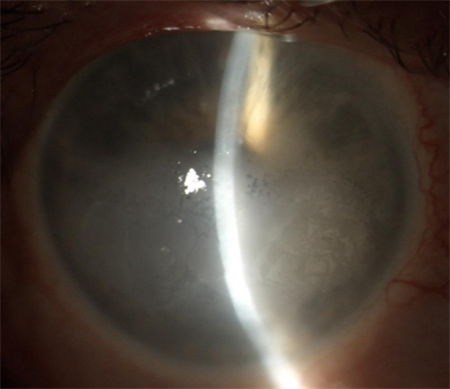Posterior polymorphous corneal dystrophy (PPCD) is a genetically heterogeneous disorder with autosomal dominant inheritance. It is most prevalent in the Czech Republic, where it affects approximately 1 in 100 000 individuals. At the cellular level, the hallmark of PPCD is abnormal proliferation due to loss of cell cycle regulation. The endpoint is loss of endothelial cell function, that leads to corneal oedema and hence a significant reduction of visual acuity (Figure). Additionally, aberrant migration of endothelial cells over the trabecular meshwork leads to secondary glaucoma, which may result in total blindness.
We have collected samples from over 120 individuals with PPCD; the largest cohort of this disorder in the world, to the best of our knowledge. Until recently, the molecular genetic cause of disease was known only for approximately 30% of probands: those individuals with point mutations or small indels in ZEB1 (Zinc finger E-box binding homeobox 1). We have found that PPCD1 is caused by mutations in the promoter of OVOL2 (Ovo-Like Zinc Finger 2). OVOL2 encodes a transcription factor that induces mesenchymal-to-epithelial transition and is a direct transcriptional repressor of ZEB1. In addition, we have found approximately one third of all mutations in ZEB1 associated with PPCD3, including the first identification of large heterozygous deletions encompassing ZEB1. Although to date we have identified the disease-causing mutation in 77% of Czech PPCD families, deeper insights into the disease mechanism are still outstanding, providing us with an opportunity for future research.
Figure: Anterior segment photograph showing advanced corneal edema in a patient with posterior polymorphous corneal dystrophy.

Davidson AE, Liskova P, Evans CJ, Dudakova L, Nosková L, Pontikos N, Hartmannová H, Hodaňová K, Stránecký V, Kozmík Z, Levis HJ, Idigo N, Sasai N, Maher GJ, Bellingham J, Veli N, Ebenezer ND, Cheetham ME, Daniels JT, Thaung CM, Jirsova K, Plagnol V, Filipec M, Kmoch S, Tuft SJ, Hardcastle AJ. Autosomal-Dominant Corneal Endothelial Dystrophies CHED1 and PPCD1 Are Allelic Disorders Caused by Non-coding Mutations in the Promoter of OVOL2. Am J Hum Genet. 2016 Jan 7;98(1):75-89. PubMed PMID: 26749309
Liskova P, Evans CJ, Davidson AE, Zaliova M, Dudakova L, Trkova M, Stranecky V, Carnt N, Plagnol V, Vincent AL, Tuft SJ, Hardcastle AJ. Heterozygous deletions at the ZEB1 locus verify haploinsufficiency as the mechanism of disease for posterior polymorphous corneal dystrophy type 3. Eur J Hum Genet. 2015 Oct 28. doi: 10.1038/ejhg.2015.232.

